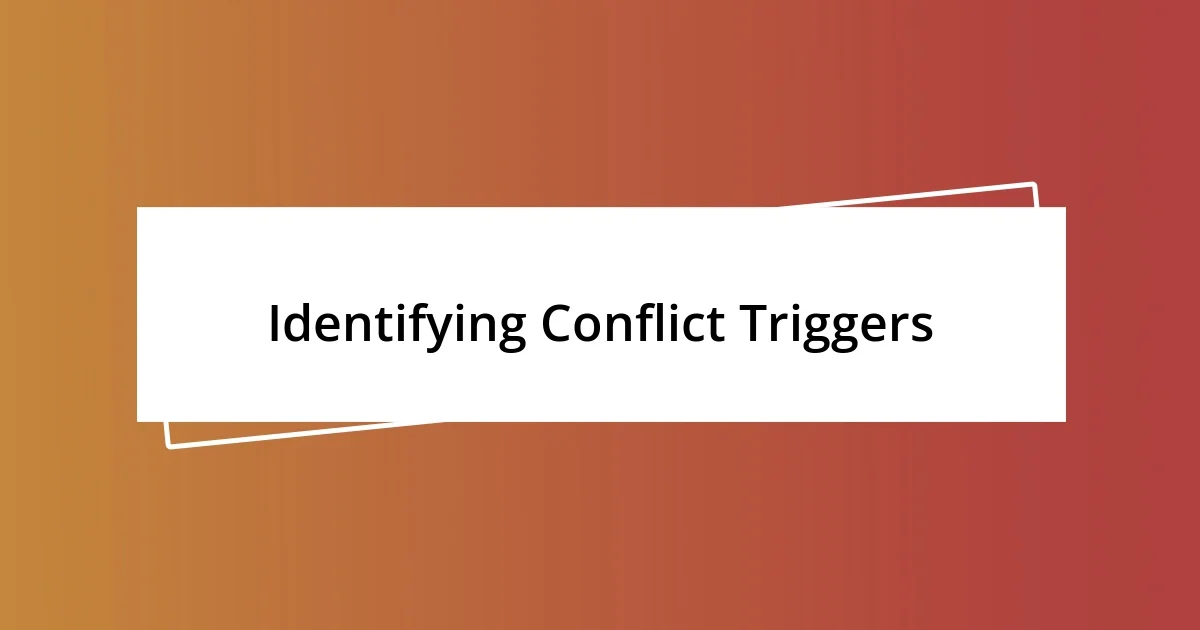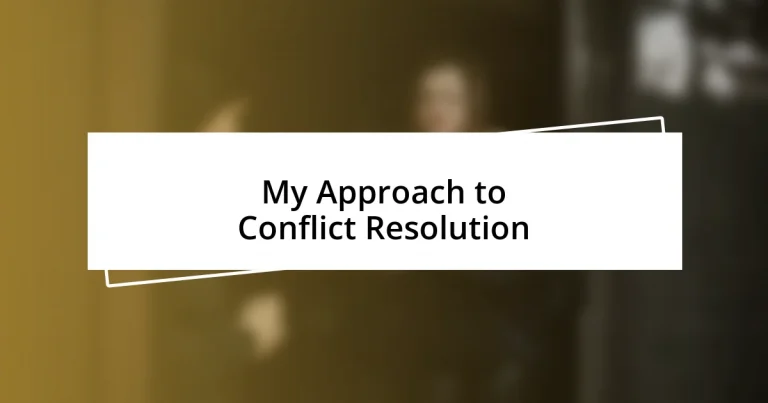Key takeaways:
- Empathy and effective communication, including active listening and using “I” statements, are crucial for resolving conflicts and fostering understanding.
- Identifying personal and external conflict triggers aids in managing emotional responses and enhances conflict navigation.
- Creating win-win solutions through open dialogue, respect, and creativity promotes collaboration and strengthens relationships among parties involved.

Understanding Conflict Resolution
Understanding conflict resolution starts with recognizing that conflict is a natural part of human interaction. I remember a time when a misunderstanding with a colleague turned into a heated disagreement. It made me realize that open communication is crucial; without it, feelings can fester and escalate tensions.
One of the most important aspects of conflict resolution is empathy. I’ve often found that putting myself in another person’s shoes helps me appreciate their perspective. Have you ever considered how a simple act of listening can shift the entire dynamic of a confrontation? It’s fascinating how often we overlook this powerful tool in favor of defending our own views.
Moreover, effective conflict resolution isn’t about winning or losing; it’s about finding common ground. In a recent situation, I was part of a team that experienced differing opinions on a project direction. By focusing on our shared goals rather than our individual agendas, we not only resolved our differences but also strengthened our collaboration. Wouldn’t you agree that, at its core, conflict resolution is truly about fostering healthier relationships?

Identifying Conflict Triggers
Identifying conflict triggers requires self-awareness and an understanding of the dynamics around us. I’ve had experiences where minor comments escalated simply because of underlying stress or unmet expectations. For instance, during a high-pressure project, I found that my irritation often flared up over seemingly insignificant things, like a colleague interrupting me. Recognizing these patterns made it clear that my emotional state significantly influenced how I reacted to others.
To effectively identify these triggers, consider the following:
- Emotional Responses: Notice when you feel defensive, angry, or upset during interactions.
- Patterns in Behavior: Reflect on recurring themes in conflicts; are they often related to time pressure or communication style?
- Environmental Factors: Acknowledge the role of external stressors, such as deadlines or personal issues, in fueling conflicts.
- Expectations: Think about whether your expectations in situations align with reality; misalignments can spark disagreements.
Understanding these aspects can truly shape how we navigate conflicts in the future.

Effective Communication Strategies
Effective communication is at the heart of resolving conflicts. Just recently, I found myself in a disagreement with a friend about a shared project. Instead of jumping to conclusions, I took a moment to ask open-ended questions to understand their viewpoint better. It was eye-opening! The simple act of inquiry transformed the conversation, making us both feel heard and respected. Have you ever noticed how a thoughtful question can diffuse tension and invite collaboration?
Active listening is another vital strategy I’ve continuously witnessed in my journey. There was a time when I was so focused on expressing my opinion that I missed crucial points from my partner during a discussion. Once I consciously practiced listening, I realized how much I was actually missing. Reflecting back on what the other person says, or even paraphrasing, can show that you’re genuinely engaged. Isn’t it fascinating how effective listening changes the entire tone of a conversation?
Additionally, using “I” statements rather than “you” statements can significantly alter the way messages are received. For instance, instead of saying, “You never listen to me,” I learned to say, “I feel overlooked when I’m not acknowledged.” This shift not only reduces defensiveness but also fosters a more constructive dialogue. Through these experiences, I’ve noticed that incorporating effective communication strategies encourages an environment where conflicts can transform into opportunities for deeper understanding.
| Communication Strategy | Description |
|---|---|
| Open-Ended Questions | Encourages elaboration and understanding by inviting detailed responses. |
| Active Listening | Involves fully focusing, understanding, and responding to what’s being said. |
| “I” Statements | Expresses personal feelings and perceptions, minimizing blame. |

Collaborative Problem Solving Techniques
Finding common ground is essential in collaborative problem-solving. I once facilitated a team session where we were stuck on a project’s direction, with each member pushing their own agenda. By encouraging everyone to share their motivations and concerns, we discovered overlapping goals that united us. Have you experienced this? When people feel invested in a shared vision, they become more willing to compromise.
Another technique I highly recommend is brainstorming without judgment. In a workshop setting, I’ve seen ideas flow freely once we established the ground rule that no suggestion would be criticized. This created an atmosphere of trust where participants felt safe to express even the wildest thoughts. It was surprising to watch how many innovative solutions emerged from what initially seemed like chaos. How might your group benefit from unleashing creativity this way?
Finally, I’ve found that establishing follow-up agreements solidifies commitment in collaborative efforts. After negotiating a plan with my colleagues, we decided to check in every week to assess our progress and adjust as needed. This ongoing accountability kept us motivated and aligned. Isn’t it fascinating how a simple structure can enhance team dynamics and ensure everyone stays engaged in the problem-solving process?

Emotional Intelligence in Conflict
Emotional intelligence plays a pivotal role in navigating conflict. I recall a time when my team was at odds during a crucial project meeting. Instead of letting frustration take over, I paused to assess my own feelings and recognize those of my colleagues. Acknowledging that everyone was under pressure allowed me to approach the situation with empathy, fostering a more constructive atmosphere. Have you ever noticed how identifying emotions can shift the dynamic of a challenging conversation?
Being aware of my emotions helps me regulate responses during tense moments. I remember a heated discussion with a family member where I could feel my irritation bubbling up. Rather than lashing out, I took a deep breath and shared my feelings. This simple act of self-awareness not only calmed me down but also opened the door for a more open exchange. Isn’t it interesting how emotional regulation can transform conflict into a dialogue?
Additionally, understanding others’ emotional states can guide my actions effectively. In a team project, recognizing a colleague’s anxiety allowed me to offer support, showing that their feelings mattered. I made it a point to check in with them regularly, which not only eased their stress but also strengthened our collaboration. How often do we miss opportunities to build connections just by being attuned to the emotions of those around us?

Creating Win-Win Solutions
Creating win-win solutions is about fostering an environment where everyone feels heard and valued. I remember a particularly tense negotiation with a vendor where we both had strong positions. Instead of sticking rigidly to our demands, I invited them to share their priorities and constraints. This open dialogue not only helped us identify shared interests but ultimately led to a solution that benefited both parties. Isn’t it remarkable how transparency can pave the way for collaboration?
Emphasizing the importance of mutual respect, I’ve seen firsthand how small gestures can significantly impact the negotiation process. During a community project, I made it a point to acknowledge the contributions of each stakeholder, regardless of the size. This simple act shifted the focus from individual gain to collective success. When people feel respected, they are naturally more inclined to look for common ground. Who wouldn’t want to work collaboratively when everyone’s efforts are recognized?
Lastly, I believe that creativity is a key ingredient in crafting effective win-win outcomes. In one unforgettable brainstorming session, my team was stuck, caught in traditional ways of thinking. By introducing a playful element—like imagining the solution as if it were part of a movie—we unlocked innovative ideas that no one had previously considered. It surprised me how breaking away from rigid frameworks can lead to synergistic solutions. Have you ever found that a shift in perspective changed the way you approached a problem?

Implementing Conflict Resolution Plans
Implementing conflict resolution plans means putting our strategies into action and being open to adapting them as needed. I once led a team workshop where we laid out our conflict resolution plan on paper, but when a disagreement arose, we had to pivot quickly. By encouraging everyone to express their ideas freely in the moment, we created a responsive environment that truly reflected our plan’s intent. Have you ever faced a situation where sticking too rigidly to a plan backfired?
When I reflect on the implementation phase, communication stands out as the backbone of any successful resolution. During a challenging phase in a previous project, we established a daily check-in to openly discuss any brewing conflicts. This simple yet consistent effort not only strengthened our relationships but also surfaced underlying issues before they escalated. I often wonder how many conflicts could be diffused with just a few minutes of honest conversation every day.
It’s also crucial to personalize the plan based on individual dynamics. I remember adjusting our approach with a team member who had a very different communication style from the rest of us. By taking time to understand their perspective and modifying our conflict resolution tactics accordingly, we fostered a stronger sense of trust and collaboration. How often do we stop to think about the unique ways people communicate and how that plays into conflict?













